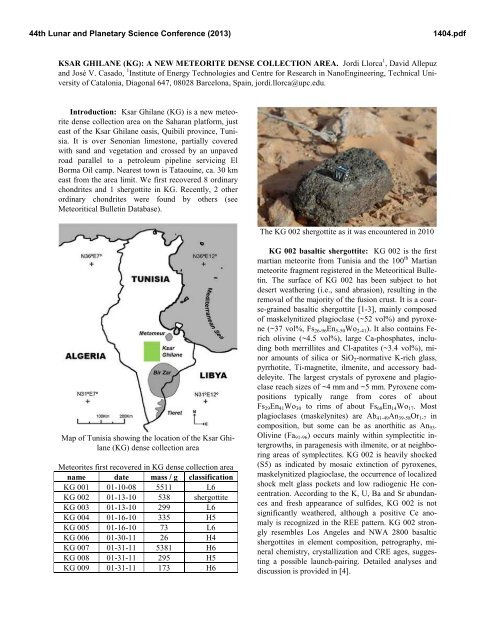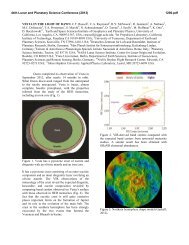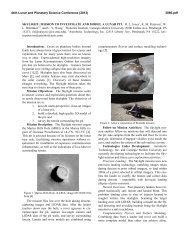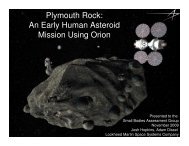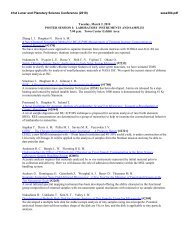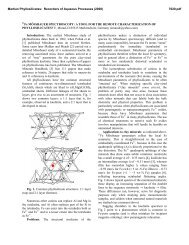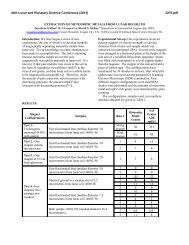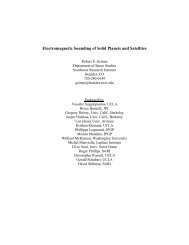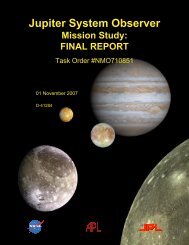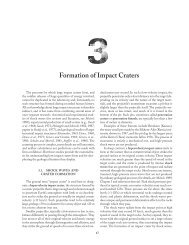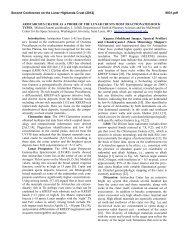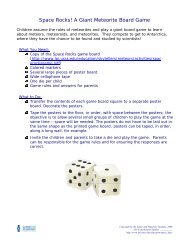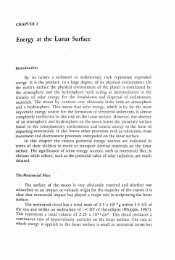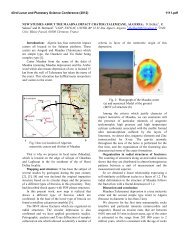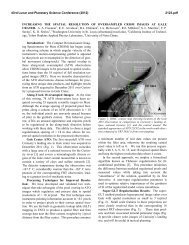Ksar Ghilane (KG): A New Meteorite Dense Collection - Lunar and ...
Ksar Ghilane (KG): A New Meteorite Dense Collection - Lunar and ...
Ksar Ghilane (KG): A New Meteorite Dense Collection - Lunar and ...
You also want an ePaper? Increase the reach of your titles
YUMPU automatically turns print PDFs into web optimized ePapers that Google loves.
44th <strong>Lunar</strong> <strong>and</strong> Planetary Science Conference (2013)<br />
KSAR GHILANE (<strong>KG</strong>): A NEW METEORITE DENSE COLLECTION AREA. Jordi Llorca 1 , David Allepuz<br />
<strong>and</strong> José V. Casado, 1 Institute of Energy Technologies <strong>and</strong> Centre for Research in NanoEngineering, Technical University<br />
of Catalonia, Diagonal 647, 08028 Barcelona, Spain, jordi.llorca@upc.edu.<br />
Introduction: <strong>Ksar</strong> <strong>Ghilane</strong> (<strong>KG</strong>) is a new meteorite<br />
dense collection area on the Saharan platform, just<br />
east of the <strong>Ksar</strong> <strong>Ghilane</strong> oasis, Quibili province, Tunisia.<br />
It is over Senonian limestone, partially covered<br />
with s<strong>and</strong> <strong>and</strong> vegetation <strong>and</strong> crossed by an unpaved<br />
road parallel to a petroleum pipeline servicing El<br />
Borma Oil camp. Nearest town is Tataouine, ca. 30 km<br />
east from the area limit. We first recovered 8 ordinary<br />
chondrites <strong>and</strong> 1 shergottite in <strong>KG</strong>. Recently, 2 other<br />
ordinary chondrites were found by others (see<br />
Meteoritical Bulletin Database).<br />
Map of Tunisia showing the location of the <strong>Ksar</strong> <strong>Ghilane</strong><br />
(<strong>KG</strong>) dense collection area<br />
<strong>Meteorite</strong>s first recovered in <strong>KG</strong> dense collection area<br />
name date mass / g classification<br />
<strong>KG</strong> 001 01-10-08 5511 L6<br />
<strong>KG</strong> 002 01-13-10 538 shergottite<br />
<strong>KG</strong> 003 01-13-10 299 L6<br />
<strong>KG</strong> 004 01-16-10 335 H5<br />
<strong>KG</strong> 005 01-16-10 73 L6<br />
<strong>KG</strong> 006 01-30-11 26 H4<br />
<strong>KG</strong> 007 01-31-11 5381 H6<br />
<strong>KG</strong> 008 01-31-11 295 H5<br />
<strong>KG</strong> 009 01-31-11 173 H6<br />
The <strong>KG</strong> 002 shergottite as it was encountered in 2010<br />
<strong>KG</strong> 002 basaltic shergottite: <strong>KG</strong> 002 is the first<br />
martian meteorite from Tunisia <strong>and</strong> the 100 th Martian<br />
meteorite fragment registered in the Meteoritical Bulletin.<br />
The surface of <strong>KG</strong> 002 has been subject to hot<br />
desert weathering (i.e., s<strong>and</strong> abrasion), resulting in the<br />
removal of the majority of the fusion crust. It is a coarse-grained<br />
basaltic shergottite [1-3], mainly composed<br />
of maskelynitized plagioclase (~52 vol%) <strong>and</strong> pyroxene<br />
(~37 vol%, Fs26-96En5-50Wo2-41). It also contains Ferich<br />
olivine (~4.5 vol%), large Ca-phosphates, including<br />
both merrillites <strong>and</strong> Cl-apatites (~3.4 vol%), minor<br />
amounts of silica or SiO2-normative K-rich glass,<br />
pyrrhotite, Ti-magnetite, ilmenite, <strong>and</strong> accessory baddeleyite.<br />
The largest crystals of pyroxene <strong>and</strong> plagioclase<br />
reach sizes of ~4 mm <strong>and</strong> ~5 mm. Pyroxene compositions<br />
typically range from cores of about<br />
Fs29En41Wo30 to rims of about Fs68En14Wo17. Most<br />
plagioclases (maskelynites) are Ab41-49An39-58Or1-7 in<br />
composition, but some can be as anorthitic as An93.<br />
Olivine (Fa91-96) occurs mainly within symplectitic intergrowths,<br />
in paragenesis with ilmenite, or at neighboring<br />
areas of symplectites. <strong>KG</strong> 002 is heavily shocked<br />
(S5) as indicated by mosaic extinction of pyroxenes,<br />
maskelynitized plagioclase, the occurrence of localized<br />
shock melt glass pockets <strong>and</strong> low radiogenic He concentration.<br />
According to the K, U, Ba <strong>and</strong> Sr abundances<br />
<strong>and</strong> fresh appearance of sulfides, <strong>KG</strong> 002 is not<br />
significantly weathered, although a positive Ce anomaly<br />
is recognized in the REE pattern. <strong>KG</strong> 002 strongly<br />
resembles Los Angeles <strong>and</strong> NWA 2800 basaltic<br />
shergottites in element composition, petrography, mineral<br />
chemistry, crystallization <strong>and</strong> CRE ages, suggesting<br />
a possible launch-pairing. Detailed analyses <strong>and</strong><br />
discussion is provided in [4].<br />
1404.pdf
44th <strong>Lunar</strong> <strong>and</strong> Planetary Science Conference (2013)<br />
Optical <strong>and</strong> BE images of the <strong>KG</strong> 002 shergottite<br />
<strong>KG</strong> Ordinary chondrites: <strong>KG</strong> 001 (129 pieces,<br />
L6, S3, W2, Fa23, Fs21.2, Wo1.7); <strong>KG</strong> 003 (1 piece, L6,<br />
S2, W2, Fa24.1, Fs20.4, Wo1.3); <strong>KG</strong> 004 (1 piece, H5, S1,<br />
W2, Fa19.2, Fs16.9, Wo0.9); <strong>KG</strong> 005 (3 pieces, L6, S4,<br />
W3, Fa24.8, Fs20.0, Wo1.1); <strong>KG</strong> 006 (18 pieces, H4, S3,<br />
W3, Fa17.2, Fs15.6, Wo0.8); <strong>KG</strong> 007 (83 pieces, H6, S4,<br />
W3, Fa18.5, Fs16.0, Wo1.1); <strong>KG</strong> 008 (3 pieces, H5, S2,<br />
W3, Fa17.8, Fs15.0, Wo2.9); <strong>KG</strong> 009 (2 pieces, H6, S4,<br />
W2, Breccia, Fa18.7, Fs17.5, Wo2.2).<br />
BE image of <strong>KG</strong> 005 (L6)<br />
BE image of <strong>KG</strong> 006 (H4)<br />
BE image of <strong>KG</strong> 007 (H6)<br />
BE image of <strong>KG</strong> 008 (H5)<br />
References: [1] Roszjar J., Bischoff A., Llorca J.,<br />
Pack A. (2012) LPS XLIII, Abstract #1780. [2] Cartwright<br />
J. A., Merchel S., Rugel G., Fimiani L., Ludwig<br />
P., Llorca J., Ott U. (2012) LPS XLIII, Abstract #1213.<br />
[3] Hoffmann V. H., Llorca J., Molins E., Mikouchi T.,<br />
Funaki F., Kaliwoda M., Hochleitner R., Yamamoto<br />
Y., Kodama K. (2012) 75th Annual Meeting of the<br />
Meteoritical Society, Abstract #5107. [4] Llorca J.,<br />
Roszjar J., Cartwright J. A., Bischoff A., Ott U., Pack<br />
A., Merchel S., Rugel G., Fimiani L., Ludwig P.,<br />
Casado J. V., Allepuz D. (2013) Meteoritics & Planet.<br />
Sci., in press.<br />
1404.pdf


